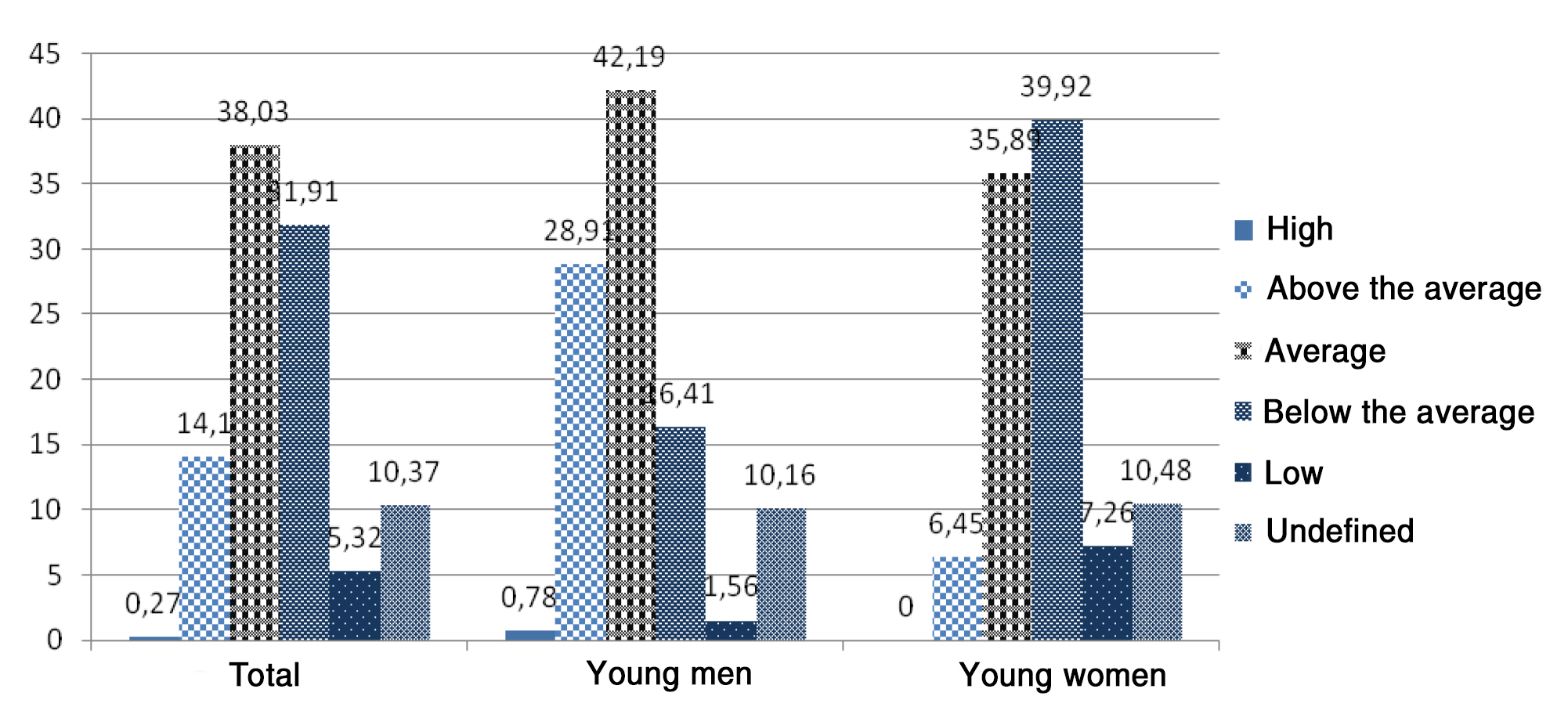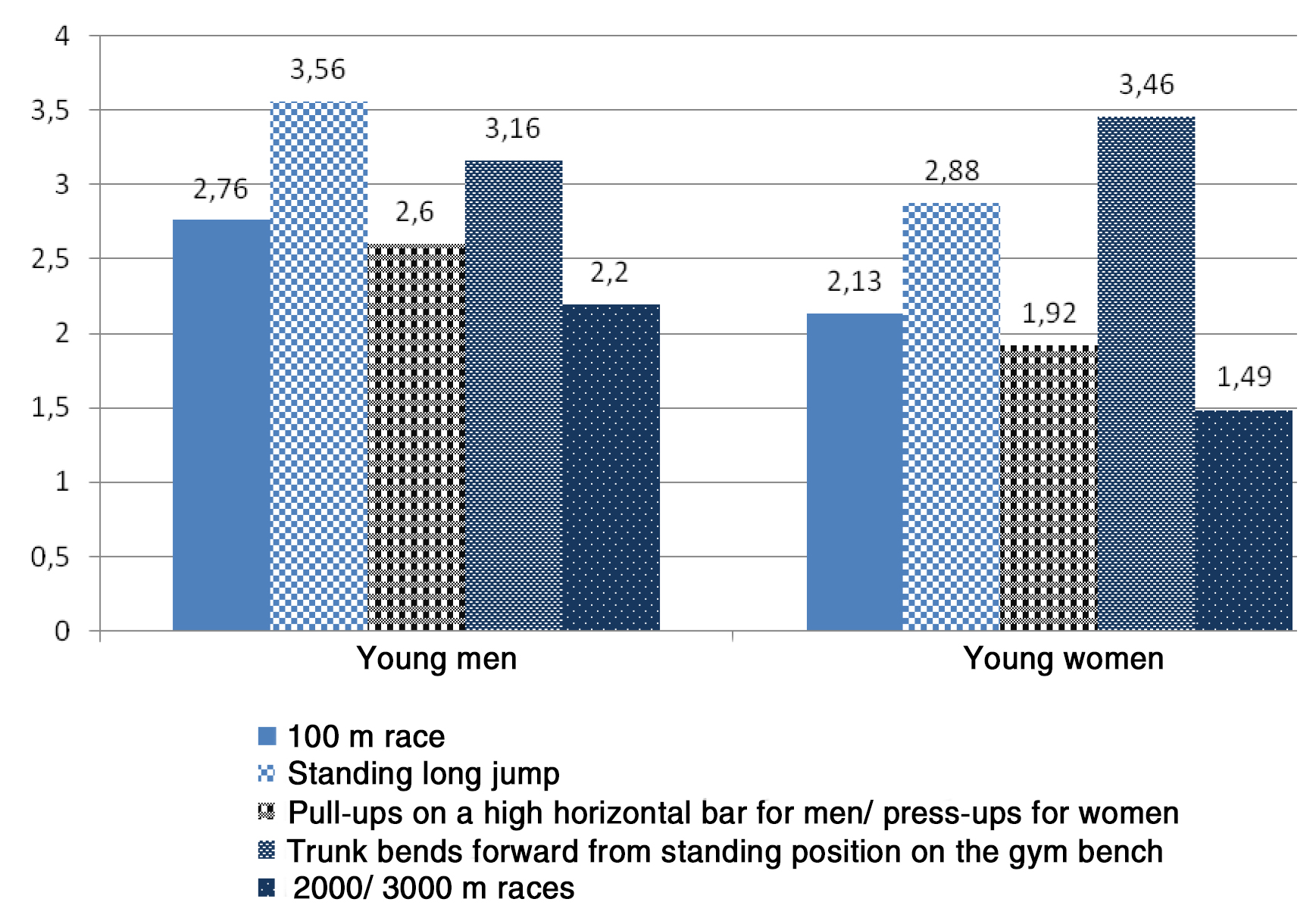Agricultural Academy students' fitness rating in context of Russian physical culture and sport "GTO" complex requirements
Фотографии:
ˑ:
Associate Professor, PhD, Honoured teacher of Russia S.N. Blinkov
Samara State Agricultural Academy (SSAA), Samara
Keywords: physical fitness, motor quality tests, motor quality development, Russian Physical Culture and Sport Complex “Ready for Labour and Defence (GTO)”.
Introduction
A few recent studies have demonstrated that the current physical fitness levels of the Russian university students and schoolchildren are alarmingly low, particularly in the aerobic endurance tests [1-2, 5-8]. This fact is now explained by a variety of reasons dominated by the too low motor activity of the students who fail to maintain the weekly motor activity on at least the minimum recommended health-support levels and, as a result, are diagnosed by different health impairments and low mental and physical working capacity, and even with a variety of acute and chronic diseases as verified by the relevant disease incidence rates [3, 7].
It was since the date of the President of the Russian Federation Decree #172 of March 24, 2014 “On the Russian Physical Culture and Sport Complex “Ready for Labour and Defence (GTO)” that the relevant sport bodies started up broad-based pilot initiatives to revive and implement the GTO standards and tests. These initiatives motivated us to undertake the university students’ physical fitness tests to obtain background data on their present physical fitness standards in general and specific motor quality development levels in particular. The educational process tests were designed to include 100 m run races; 2000 m races for young women and 3000 m races for young men; long jumps from standing position; press-ups for women; pull-ups on a high horizontal bar for men; sit-ups, arms locked behind the neck 30-second tests; trunk bends forward from standing position on the gym bench; and running grenade long throw tests. Most of these tests were designed as the standard tests under the GTO Complex Grade VI for 18-29 year-olds that is applicable to the vast majority of the full-time university students. 258 university students including 163 young women and 95 young men were tested.
It should be noted that the efforts to implement the GTO system with its unified test array that gives the means to assess the key physical qualities development levels – imply high responsibility being shouldered by the university physical culture instructors and educators that need to establish and maintain a due monitoring system to assess the students’ physical fitness on a systemic basis and to come up with recommendations on the ways to develop some specific motor qualities. A set of the relevant application software tools has been developed to help the researchers assess the students’ progress and adjust the physical conditioning systems, speed up the physical training process when necessary, apply due qualitative fitness assessment criteria and produce the relevant corrective recommendations in the process [6]
Objective of the study was to assess the Samara State Agricultural Academy (SSAA) students’ fitness levels – to see if they can meet the GTO standards, and come up with recommendations on how to optimize the students’ physical training and conditioning process.
Special goals of the study were to: (1) Assess the Samara State Agricultural Academy (SSAA) 1-3- year students’ fitness levels using the modern information technology tools; and (2) Come up with recommendations to improve the students' motor activity and to optimize their physical conditioning process.
Study results and discussion
Analysis of the study data demonstrate that only 0.27% of the subject students were rated with “high” physical fitness (PF) category; 14.1% were rated with “above the average” PF category; 38.03 % with the “average” PF; 31.91% with “below the average” PF; and 5.32% of the 1-3-year students were rated with the “low” PF category; with the balance of 10.37% being classified with the “undefined” PF category as these students failed to pass all or some of the tests for different reasons (Figure 1).
Furthermore, our study has demonstrated that the tested young men basically showed high PF standards compared to the young women, as verified by the relevant high-, above-the-average- and average-physical-fitness rates for the tested young men (0.78 %, 28.9% and 42.19% respectively) versus that for the tested young women (0.0 %, 6.45% and 35.89% respectively).

Figure 1. 1-3-year SSAA students’ physical fitness rates, %
In addition, the tested young men showed better developed speed qualities than that of the young women as verified by the 100 m race test results. Being rated on a five-point scale, the young women scored only 2.13 points of the possible 5, whilst the young men scored 2.76 points in the test. The speed-and-strength motor qualities, as assessed by the standing long jumps, were also found being better developed in the tested young men who scored 3.56 points versus 2.88 points scored by the tested young women (Figure 2).
As far as the strength qualities are concerned, the tested young men were also ahead in the tests with the average score of 2.6 points that was 0.68 points higher than that scored by the tested women. Moreover, the tested young men showed much better aerobic endurance rates than their female fellow students as verified by the average score of 2.2 points compared to 1.49 points scored by the women. The tests showed the tested young women being ahead of the men only in one of the tested motor qualities that is flexibility, since the flexibility tests scored 3.46 points for the women’s group that was 0.3 higher than the result of the young men’s group (Figure 2).
It may be worth special mentioning that it was the aerobic endurance that was rated as the least developed physical quality of the tested young men, whilst the speed-and-strength quality and flexibility were rated as the best-developed qualities in this test group (Figure 2, Table 1).

Figure 2. Physical quality development scores of the tested SSAA students, on a five-point scale
Our analysis of the study data showed the tested young women lagging behind in the speed- and strength physical qualities and overall endurance tests as verified by the 100 m race, press-ups and 2000 m race tests (Figure 2 and Table 1).
As demonstrated by the running grenade long throw tests and the trunk bends forward from standing position on the gym bench tests, these were the speed-and-strength motor qualities of the shoulder girdle and flexibility that were rated as the best-developed physical qualities of the subject young women (Fig. 1, 2, Table 1).
As demonstrated by analysis of the study data, 72.9% of the young men group were able to meet requirements of the GTO grade standards in the 100 m race test, with 24.3%, 40.5% and 8.1% of the students being qualified for the golden, silver and bronze GTO grade badges, respectively. In the young women’s group, only 33.81% were able to meet the GTO standards in the 100 m race test, with 11.76 %, 13.23% and 8.82% being qualified for the golden, silver and bronze GTO grade badges, respectively (Table 1).
Assessments of the speed-and-strength qualities as verified by the standing long jumps showed that the requirements of the GTO standards were met by 71.7% of the tested young men (with 38.46%, 20.5% and 12.8% of the students being qualified for the golden, silver and bronze GTO grade badges, respectively). In the tested young women’s group, 55.57% fulfilled the requirements of the GTO grade standards in the same test, with 13.6%, 27.6% and 14.81% of the women being qualified for the golden, silver and bronze GTO grade badges, respectively (Table 1).
The strength-endurance assessments by the pull-ups on a high horizontal bar for young men showed that 55.0% of the subjects successfully passed the tests and fulfilled the relevant requirements of the GTO standards, with 17.5%, 32.5% and 5.0% being qualified for the golden, silver and bronze GTO grade badges, respectively. The strength-endurance assessments of the young women group by the press-ups test resulted in 40.18% of the women being successful in meeting the relevant requirements of the GTO standards, with 25.88%, 2.36% and 12.94% of them being qualified for the golden, silver and bronze GTO grade badges, respectively (Table 1).
The trunk bends forward from standing position on the gym bench tests resulted in 88.1% of the young men being successful in meeting the GTO requirements, with 47.6%, 35.7% and 4.8% of the group being qualified for the golden, silver and bronze GTO grade badges, respectively. The tested young women were even more successful in the test to meet the GTO requirements as 89.06% of them passed the test with 44.7%, 37.6% and 7.06% of the women being qualified for the golden, silver and bronze GTO grade badges, respectively (Table 1).
The running grenade long throw tests resulted in 68.3% of the tested young men group being successful in fulfilling the relevant GTO requirements, with 47.4%, 5.3% and 15.9% of the group being qualified for the golden, silver and bronze GTO grade badges, respectively. The tested young women were even more successful in the grenade test as 87.8% of them passed the test, with 30.3%, 36.3% and 21.2% of the women’s group being qualified for the golden, silver and bronze GTO grade badges, respectively (Table 1).
The 200 m women’s race tests and 3000 m men’s race tests were not that successful for the subject university students as only 56.0% of the tested young men and 31.08% of young women fulfilled the relevant GTO grade requirements. The 3000 m race test of the young men group resulted in 28.0%, 12.0 % and 16.0% of them being qualified for the golden, silver and bronze GTO grade badges, respectively (Table 1). The statistical analysis of the test data showed that the 2000 m race test of the young women group resulted in 6.34%, 11.28% and 13.46% of the women being qualified for the golden, silver and bronze GTO grade badges, respectively (Table 1).
Therefore, the summarized results of the students’ physical fitness tests give the reasons to conclude that the 1-3-year Samara SAA students of both sexes are poorly fit in terms of mostly aerobic endurance qualities. The speed motor qualities and strength endurance qualities were found to be less developed in the young women group. This may be indicative of most of the students giving too little priority to self-training and conditioning practices, with the running practices being the least popular among them. Efforts need to be taken to make them aware of the fact that the minimum health-supporting motor activity of university students need to be maintained at the level of at least 8-10 hours per week.
Therefore, the above motor quality tests give reasons to believe that special initiatives need to be taken to improve the physical fitness levels of the students that may be designed, in our opinion, to: (a) step up the physical activity workloads in the university hours; and (b) implement the individualized and typology-based approaches in the students’ physical conditioning systems [4].
Table 1. Physical fitness indices of the 1-3-year Samara SSA students as provided by the motor quality tests and the relevant GTO grade badge qualification tests
|
Tests |
Young men (n=95) |
Young women (n=163) |
||
|
Test result (М±m) |
Test success rate, % |
Test result (М±m) |
Test success rate, % |
|
|
100 m race test, time |
14.22±0.16 |
G. badge: 24.3 S. badge: 40.5 Br. badge: 8.1 |
18.13±0.12 |
G. badge: 11,76 S. badge: 13,23 Br. badge: 8,82 |
|
2000 m race for women, 3000 m race for men, time
|
14.55,0±9,2 |
G. badge: 28,0 S. badge: 12,0 Br. badge: 16,0 |
12.46,5±8,7 |
G. badge: 6,34 S. badge: 11,28 Br. badge: 13,46 |
|
Running grenade long throw using 700 gram grenade for men and 500 gram grenade for women, m |
34,65±1,72 |
G. badge: 47,3 S. badge: 5,3 Br. badge: 15,9 |
18,47±0,76 |
G. badge: 30,3 S. badge: 36,3 Br. badge: 21,2 |
|
Pull-ups on a high horizontal bar for men/ press-ups for women, times |
10,48±0,48 |
G. badge: 17,5 S. badge: 32,5 Br. badge: 5,0 |
10,93±0,53
|
G. badge: 25,88 S. badge: 2,36 Br. badge: 12,94 |
|
Standing long jumps, cm |
228,6±2,27 |
G. badge: 38,4 S. badge: 20,5 Br. badge: 12,8 |
168,8±1,55 |
G. badge:13,6 S. badge: 27,16 Br. badge: 14,81 |
|
Trunk bends forward from standing position on the gym bench |
12,9±0,61 |
G. badge: 47,6 S. badge: 35,7 Br. badge: 4,8 |
14,12±0,4 |
G. badge: 44,7 S. badge: 37,6 Br. badge: 7,06
|
The federal government initiative to implement the upgraded version of the GTO Complex provides good reasons for the university curricula being considered the basic and compulsory framework for the university students’ physical training and conditioning system being reformed. The physical fitness improvement practices shall be designed mostly within the existing General Physical Conditioning (GPC) system, with the individual progress of the students being subject for regular monitoring with necessary adjustments to the individual physical quality development practices being made in the process.
Therefore, we believe that the university physical conditioning system reform based on the existing GPC system with due progress monitoring and rating components and the individualized typology-based approaches, with due contribution of the modern information technologies in the students’ physical conditioning systems – may be quite effective.
The anticipated improvements in the university students’ motor activity will be beneficial for their physical fitness levels on the whole, with the progress of the reform being assessed by the relevant monitoring system and the process tests giving the key data indicative of the students’ physical fitness improvements.
Conclusions
1. The university students’ physical conditioning systems shall be designed so as to give higher priority to the overall-endurance and speed-endurance developing practices in application to the students of both sexes, the practices being dominated by long-distance races with acceleration runs on spans of up to 120 m, and to the strength-developing practices focused on the arms extension/ flexion muscle groups.
2. For the university students’ motor activity improvement efforts being duly motivated, it may be appropriate to introduce the relevant physical fitness rating system based on the modern information technologies.
3. The 1-3-year university students must take efforts to increase their self-controlled motor activity time up to 5-6 hours per week. To make sure that the physical training and conditioning workloads are managed on a most efficient basis, it is recommended to apply the individualized typology-based approach (with due consideration for the trainees' somatotypes).
4. To support the efforts to improve the Samara SSA students physical education system and to increase the motor activity of the students, we recommend to establish a special office or laboratory to monitor progress of the reform as verified by the relevant key physical fitness/ health indicators to ensure the physical condition and health standards of the university students being monitored and assessed on a systemic basis.
References
- Blinkov S.N. Issledovanie fizicheskoy podgotovlennosti sel'skikh i gorodskikh shkolnits 7-17 let Ulyanovskoy oblasti [Physical fitness of rural and urban schoolgirls of 7-17 years of age in Ulyanovsk region]. Uchenye zapiski universiteta imeni P.F. Lesgafta, 2015, no. 8 (126), pp. 16-21.
- Blinkov S.N. Kontrol i korrektsiya fizicheskoy podgotovlennosti studentov 1 kursa Samarskoy GSKhA s is-polzovaniem informatsionnykh tekhnologiy [Information technology in monitoring and correction of physical fitness of 1-year students of Samara State Agricultural Academy]. Pedagogika i psikhologiya – 2015: sbornik materialov mezhdunarodnoy nauchnoy konferentsii, 2 sessiya [Proc. intern. scie. conf. "Pedagogics and Psychology - 2015"], Session 2. Moscow: RusAlyans Sova publ., 2015, pp. 21-28.
- Blinkov S.N. Organizatsiya i soderzhanie fizkul'turno-ozdorovitelnoy raboty v selskoy shkole [Organization and content of health and fitness activities in rural schools]. S.N. Blinkov, S.P. Levushkin. – Ulyanovsk: UlSTU publ., 2012, 191 p.
- Blinkov S.N., Vasileva N.Y., Laptev A.I. Realizatsiya individualno-tipologicheskogo podkhoda v fizicheskoy podgotovke shkolnits 15-17 let [Individual typological approach to physical training of schoolgirls of 15-17 years of age]. Vestnik sportivnoy nauki, 2010, no. 3, pp. 22-27.
- Blinkov S.N., Levushkin S.P. Sravnitelny analiz fizicheskoy podgotovlennosti selskikh i gorodskikh shkolnikov 7-17 let Ulyanovskoy oblasti [Comparative analysis of physical fitness of rural and urban schoolchildren of 7-17 years of age in Ulyanovsk Region]. Uchenye zapiski universiteta imeni P.F. Lesgafta, 2015, no. 7 (125), pp. 38-43.
- Levushkin S.P., Zhukov O.F., Blinkov S.N., Kodolova F.M. Ispolzovanie kompyuternykh tekhnologiy v professional'noy deyatel'nosti spetsialista po fizicheskoy kulture [Computer technologies in professional activity of physical education specialist]. Ekologiya cheloveka. An.1, 2006, pp. 65-66.
- Levushkin S.P., Khamzina V.A., Blinkov S.N. Issledovanie fizicheskogo sostoyaniya uchashcheysya molodezhi [Study of students' physical condition]. Ulyanovsk: UlSTU publ., 2013, 162 p.
- Levushkin S.P., Blinkov S.N., Meshcheryakov A.V. Normativy fizicheskoy podgotovlennosti shkolnikov g. Samary. Uchebno-metodicheskoe posobie [Physical fitness standards for Samara students. Teaching aid]. Moscow: Pero publ., 2014, 22 p.
Corresponding author: blinkovsn@mail.ru
Abstract
The study offers an overview of the university students’ physical fitness standards as of the late 2014-15 academic year. The researchers have analyzed whether or not the sampled university students’ overall physical fitness standards and key motor qualities development levels meet the requirements of the national Russian Physical Culture and Sport Complex “Ready for Labour and Defence (GTO)”. A set of the motor quality tests was applied to assess the Samara State Agricultural Academy (SSAA) students’ fitness levels – to see if they meet the GTO standards to qualify for the relevant GTO grade badges. The study has found the university students of both sexes being most poorly fit for the endurance long-distance run races under the GTO tests. The study offers recommendations to improve the students’ motor qualities development standards to help them meet the requirements of the national Russian Physical Culture and Sport Complex “Ready for Labour and Defence (GTO)”.



